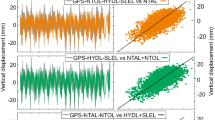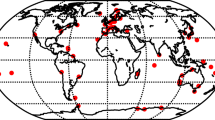Abstract
Non-tidal loading (NTL) deforms the earth’s surface, adding variability to the coordinates of geodetic sites. Yet, according to the IERS Conventions, there are no recommended surface-mass change models to account for NTL deformation in geodetic position time series. We investigate the NTL signal recorded at 585 GPS stations at different frequency bands, from day to years, by comparing GPS estimated displacements to modeled environmental loading. We used up-to-date and high-resolution (both temporal and spatial) models to account for NTL induced by mass changes in the atmosphere, oceans, and continental hydrology. Vertical land motions variability is reduced on average by up to 20% when correcting the series for non-tidal atmospheric and oceanic loading, employing either barotropic or baroclinic ocean models. We then focus on characterizing the ocean response to air-pressure variations, and we observe that there are no significant differences at seasonal timescales between a barotropic ocean model forced by air pressure and winds and a more classical baroclinic ocean model forced by wind, heat and freshwater fluxes. However, any of these choices further reduces the variability by 5% compared to the classical static inverted barometer ocean response. The variability of the vertical coordinate changes is further reduced by an additional 5% by also correcting for continental hydrology loading, especially at seasonal periods. For horizontal coordinate changes, the variability is reduced by less than 5% after correcting for all studied surface-mass changes.








Similar content being viewed by others
Abbreviations
- ACC:
-
Antarctic Circumpolar Current
- CF:
-
Center of figure
- D-NTAOL:
-
Dynamic non-tidal atmospheric and oceanic loading
- DORIS:
-
Doppler orbitography and radiopositioning integrated by satellite
- ECCO:
-
Estimating the Circulation and Climate of the Ocean
- ECWMF:
-
European Centre for Medium-Range Weather Forecasts
- ELM:
-
East land motion
- GCM:
-
General circulation model
- GLDAS:
-
Global Land Data Assimilation System
- GLORYS:
-
Global Ocean ReanalYsis and Simulation
- GPS:
-
Global Positioning System
- IB:
-
Inverted barometer
- IERS:
-
International Earth Rotation and Reference Systems Service
- MERRA:
-
Modern Era Retrospective-Analysis
- NCEP:
-
National Centers for Environmental Prediction
- NLM:
-
North land motion
- NTAL:
-
Non-tidal atmospheric loading
- NTAOL:
-
Non-tidal atmospheric and oceanic loading
- NTL:
-
Non-tidal loading
- NTOL:
-
Non-tidal oceanic loading
- OGCM:
-
Ocean general circulation model
- RMS:
-
Root mean square
- SLR:
-
Satellite laser ranging
- STD:
-
Standard deviation
- TUGO-m:
-
Toulouse Unstructured Grid Ocean model
- VLBI:
-
Very long baseline interferometry
- VLM:
-
Vertical land motion
- WRMS:
-
Weighted root mean square
References
Blewitt G (2003) Self-consistency in reference frames, geocenter definition, and surface loading of the solid Earth. J Geophys Res 108(B2):2103. https://doi.org/10.1029/2002JB002082
Boehm J, Werl B, Schuh H (2006) Troposphere mapping functions for GPS and very long baseline interferometry from European Centre for Medium-Range Weather Forecasts operational analysis data. J Geophys Res 111:B02406
Boehm J, Heinkelmann R, Mendes Cerveira PJ, Pany A, Schuh H (2009) Atmospheric loading corrections at the observation level in VLBI analysis. J Geod 83:1107–1113. https://doi.org/10.1007/s00190-009-0329-y
Carrère C, Lyard F (2003) Modelling the barotropic response of the global ocean to atmospheric wind and pressure forcing—comparisons with observations. Geophys Res Lett 30(6):1275. https://doi.org/10.1029/2002GL016473
Chen G, Herring TA (1997) Effects of atmospheric azimuthal asymmetry on the analysis of space geodetic data. J Geophys Res 102:20489–20502
Collilieux X, Altamimi Z, Coulot D, van Dam T, Ray J (2010) Impact of loading effects on determination of the international terrestrial reference frame. Adv Space Res 45(4):144–154. https://doi.org/10.1016/j.asr.2009.08.024
Davis JL, Elósegui P, Mitrovica JX, Tamisiea ME (2004) Climate-driven deformation of the solid Earth from GRACE and GPS. Geophys Res Lett. https://doi.org/10.1029/2004gl021435
Desjardins C, Gegout P, Soudarin L, Biancale R (2016) Rigorous interpolation of atmospheric state parameter for ray-traced tropospheric delays. In: Sneeuw N, Novák P, Crespi M, Sansò F (eds) VIII Hotine-marussi symposium on mathematical geodesy, vol International Association of Geodesy Symposia, 142nd edn. Springer, Cham, pp 139–146. https://doi.org/10.1007/1345.2015.10
Duan J, Shum CK, Guo J, Huang Z (2012) Uncovered spurious jumps in the GRACE atmospheric de-aliasing data: potential contamination of GRACE observed mass change. Geophys J Int 191(1):83–87. https://doi.org/10.1007/s00190-009-0327-0
Eriksson D, MacMillan DS (2014) Continental hydrology loading observed by VLBI measurements. J Geod 88(7):675–690. https://doi.org/10.1007/s00190-014-0713-0
Farrell WE (1972) Deformation of the Earth by surface loads. Rev Geophys Space Phys 10:761–797
Ferry N et al (2012) GLORYS2V1 global ocean reanalysis of the altimetric era (1993–2009) at mesoscale. Merc Ocean-Q Newsl 44:10
Fratepietro F, Baker TF, Williams SDP, Van Camp M (2006) Ocean loading deformations caused by storm surges on the northwest European shelf. Geophys Res Lett. https://doi.org/10.1029/2005gl025475
Gégout P, Boy JP, Hinderer J, Ferhat G (2010) Modeling and observation of loading contribution to time-variable GPS sites positions. Int Assoc Geod Symp 135(8):651–959. https://doi.org/10.1007/978-3-642-10634-786
Geng J, Williams SDP, Teferle FN, Dodson AH (2012) Detecting storm surge loading deformations around the southern North Sea using subdaily GPS. Geophys J Int 191(2):569–578. https://doi.org/10.1111/j.1365-246X.2012.05656.x
Herring TA, King RW, McClusky SC (2010) Introduction to GAMIT-GLOBK. Massachusetts Institute of Technology, Cambridge, p 48
Jiang W, Li Z, van Dam T, Ding W (2013) Comparative analysis of different environmental loading methods and their impacts on the GPS height time series. J Geod 87(7):687–703. https://doi.org/10.1007/s00190-013-0642-3
Krásná H, Malkin Z, Böhm J (2015) Non-linear VLBI station motions and their impact on the celestial reference frame and Earth orientation parameters. J Geod 89(10):1019–1033. https://doi.org/10.1007/s00190-015-0830-4
Lyard F, Lefevre F, Letellier T, Francis O (2006) Modelling the global ocean tides: modern insights from FES2004. Ocean Dynam 56:394–415
MacMillan DS, Gipson JM (1994) Atmospheric pressure loading parameters from very long baseline interferometry observations. J Geophys Res 99(B9):18081–18087
Mangiarotti S, Cazenave A, Soudarin L, Crétaux JF (2001) Annual vertical crustal motions predicted from surface mass redistribution and observed by space geodesy. J Geophys Res 106(B3):4277–4291
Mémin A, Rogister Y, Hinderer J, Llubes M, Berthier E, Boy JP (2009) Ground deformation and gravity variations modelled from present-day ice thinning in the vicinity of glaciers. J Geodyn 48(3–5):195–203. https://doi.org/10.1016/j.jog.2009.09.006
Mémin A, Spada G, Boy JP, Rogister Y, Hinderer J (2014a) Decadal geodetic variations in Ny-Ålesund (Svalbard): role of past and present ice-mass changes. Geophys J Int 198(1):285–297. https://doi.org/10.1093/gji/ggu134
Mémin A, Watson C, Haigh I, MacPherson L, Tregoning P (2014b) Non-linear motions at Australian geodetic stations induced by non-tidal ocean loading and the passage of tropical cyclones. J Geod 88(10):927–940. https://doi.org/10.1007/s00190-014-0734-8
Petit G, Luzum B (2010) IERS Conventions (2010) IERS Technical Note No. 36, Verlag des Bundesamtes für Kartographie und Geodäsie Frankfurt am Main, pp 179
Petrov L, Boy J (2004) Study of the atmospheric pressure loading signal in very long baseline interferometry observations. J Geophys Res Solid Earth. https://doi.org/10.1029/2003jb002500
Plag HP et al (2009) The goals, achievements, and tools of modern geodesy. In: Plag HP, Pearlman M (eds) Global geodetic observing system. Springer, Berlin
Reichle RH, Koster RD, De Lannoy GJM, Forman BA, Liu Q, Mahanama SPP, Toure A (2011) Assessment and enhancement of merra land surface hydrology estimates. J Climate 24:6322–6338. https://doi.org/10.1007/s10291-011-0248-2
Rodell M et al (2004) The global land data assimilation system. Bull Am Meteor Soc 85(3):381–394
Santamaría-Gómez A, Mémin A (2015) Geodetic secular velocity errors due to interannual surface loading deformation. Geophys J Int Exp Lett 202(2):763–767. https://doi.org/10.1093/gji/ggv190
Santamaría-Gómez A, Gravelle M, Dangendorf S, Marcos M, Spada G, Wöppelmann G (2017) Uncertainty of the 20th century sea-level rise due to vertical land motion errors. Earth Planet Sci Lett 473:24–32
Schuh H, Estermann G, Crétaux JF, Bergé-Nguyen M, van Dam T (2003) Investigation of hydrological and atmospheric loading by space geodetic techniques. In: C Hwang, CK Shum, JC Li (eds) IAG Proceedings, vol 126, pp 123–132, International Workshop on Satellite Altimetry
Sósnica K, Thaller D, Dach R, Jäggi A, Beutler G (2013) Impact of loading displacements on SLR-derived parameters and on the consistency between GNSS and SLR results. J Geod 87(8):751–769. https://doi.org/10.1007/s00190-013-0644-1
Tapley BD, Bettadpur S, Watkins M, Reigber C (2004) The gravity recovery and climate experiment: mission overview and early results. Geophys Res Lett. https://doi.org/10.1029/2004gl019920
Tesmer V, Steigenberger P, Rothacher M, Boehm J, Meisel B (2009) Annual deformation signals from homogeneously reprocessed VLBI and GPS height time series. J Geod 83(10):973–988. https://doi.org/10.1007/s00190-009-0316-3
Tregoning P, van Dam TM (2005) Atmospheric pressure loading corrections applied to GPS data at the observation level. Geophys Res Lett. https://doi.org/10.1029/2005gl024104
Tregoning P, Watson C (2009) Atmospheric effects and spurious signals in GPS analyses. J Geophys Res. https://doi.org/10.1029/2009jb006344
Tregoning P, Watson C (2011) Correction to ”Atmospheric effects and spurious signals in GPS analyses”. J Geophys Res. https://doi.org/10.1029/2010jb008157
Tregoning P, Watson C, Ramillien G, McQueen H, Zhang J (2009) Detecting hydrologic deformation using GRACE and GPS. Geophys Res Lett. https://doi.org/10.1029/2009gl038718
van Dam TM, Herring TA (1994) Detection of atmospheric pressure loading using very long baseline interferometry measurements. J Geophys Res 99(B3):4505–4517
van Dam TM, Wahr JM (1987) Displacements of the Earth’s surface due to atmospheric loading: effects on gravity and baseline measurements. J Geophys Res 92(B2):1281–1286
van Dam TM, Blewitt G, Heflin MB (1994) Atmospheric pressure loading effects on Global Positioning System coordinate determinations. J Geophys Res 99(B12):23939–23950
van Dam T, Wahr J, Milly PCD, Shmakin AB, Lavallée BD, Larson KM (2001) Crustal displacements due to continental water loading. Geophys Res Lett 28(4):651–654
van Dam TM, Wahr JM, Lavallée D (2007) A comparison of annual vertical crustal displacements from GPS and gravity recovery and climate experiment (GRACE) over Europe. J Geophys Res. https://doi.org/10.1029/2006jb004335
van Dam TM, Collilieux X, Altamimi Z, Ray J (2012) Non-tidal ocean loading: amplitudes and potential effects in GPS height time series. J Geod 86(11):1043–1057. https://doi.org/10.1007/s00190-012-0564-5
Wunsch C, Stammer D (1997) Atmospheric loading and the oceanic “inverted barometer” effect. Rev Geophys 31(1):79–107
Williams SDP, Penna NT (2011) Non-tidal ocean loading effects on geodetic GPS heights. Geophys Res Lett. https://doi.org/10.1029/2011gl046940
Wunsch C, Heimbach P, Ponte R, Fukumori I, the ECCO-GODAE Consortium Members (2009) The global general circulation of the ocean estimated by the ECCO-consortium. Oceanog 22(2):88–103
Acknowledgements
This work has been partly funded by the Centre National d’Etudes Spatiales (CNES) through the TOSCA program. The work was initiated while AM was supported by an Australian Research Council Super Science Fellowship (FS110200045). ASG was supported by a FP7 Marie Curie International Outgoing Fellowship (project number 330103). All loading time series are available at the EOST/IPGS loading service (http://loading.u-strasbg.fr). We acknowledge M. Gravel for providing GPS time series from the ULR6 solutions. We also thank Florent Lyard (LEGOS, Toulouse, France) for providing the TUGO-m model.
Author information
Authors and Affiliations
Corresponding author
Additional information
Publisher's Note
Springer Nature remains neutral with regard to jurisdictional claims in published maps and institutional affiliations.
Rights and permissions
About this article
Cite this article
Mémin, A., Boy, JP. & Santamaría-Gómez, A. Correcting GPS measurements for non-tidal loading. GPS Solut 24, 45 (2020). https://doi.org/10.1007/s10291-020-0959-3
Received:
Accepted:
Published:
DOI: https://doi.org/10.1007/s10291-020-0959-3




